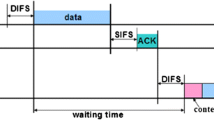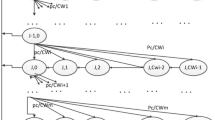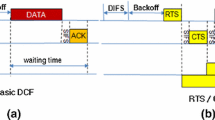Abstract
Distributed Queuing Collision Avoidance (DQCA) is an efficient MAC protocol designed for infrastructure Wireless LANs. In this paper, four algorithms are proposed that alter the FIFO scheduling order of DQCA in order to meet specific network requirements. The proposed schemes combine the efficiency of opportunistic scheduling with the QoS provisioning through service differentiation. The opportunistic policy encourages transmissions at higher rates when the channel condition is good and is implemented through a cross-layer dialogue between the PHY and the MAC layers. The key idea of service differentiation is to assign priorities to traffic flows with different requirements in order to provide QoS guarantees. The throughput, delay and jitter performance of the proposed schemes has been evaluated through simulations for a scenario with heterogeneous traffic of voice, video, best-effort and background data traffic flows.



















Similar content being viewed by others
References
Supplement to IEEE Standard for Information technology–Telecommunications and information exchange between systems–Local and metropolitan area networks–Specific requirements–Part 11: Wireless LAN Medium Access Control (MAC) and Physical Layer (PHY) specifications–Amendment 4: Further Higher Data Rate Extension in the 2.4 GHz Band. IEEE Std 802.11 g, 2003
Draft STANDARD for Information technology–Telecommunications and information exchange between systems–Local and metropolitan area networks–Specific requirements–Part 11: Wireless LAN Medium Access Control (MAC) and Physical Layer (PHY) specifications–Amendment 5: Enhancements for Higher Throughput. IEEE Unapproved Draft Std P802.11n/D5.0, May 2008
Holland G, Vaidya N, Bahl P (2001) A rate-adaptive MAC protocol for multi-hop wireless networks. In Proceedings of the 7th annual international conference on Mobile computing and networking (MobiCom ’01), pages 236–251, New York, NY, USA, 2001. ACM
Pavon JdP, Choi S (2003) Link adaptation strategy for IEEE 802.11 WLAN via received signal strength measurement. Communications, 2003. ICC ’03. IEEE International Conference on 2:1108–1113 vol.2
Shakkottai S, Rappaport T, Karlsson, P (2003) Cross-layer design for wireless networks. Communications Magazine. IEEE 41(10):74–80 doi:10.1109/MCOM.2003.1235598
Sadeghi B, Kanodia V, Sabharwal A, Knightly E (2002) Opportunistic media access for multirate ad hoc networks. In Proceedings of the 8th annual international conference on Mobile computing and networking (MobiCom ’02), pages 24–35, New York, NY, USA, 2002. ACM
Bouam S, Othman, JA (2004) 802.11 multiservices cross-layer approach for QoS management. Vehicular Technology Conference, 2004. VTC2004-Fall. IEEE 60th 4:2698–2702 Vol. 4, Sept. 2004
Wang J, Zhai H, Fang, Y (2004) Opportunistic packet scheduling and media access control for wireless LANs and multi-hop ad hoc networks. Wireless Communications and Networking Conference, 2004. WCNC. IEEE 2:1234–1239 Vol.2, March 2004
Garroppo RG, Giordano S, Lucetti S, Tavanti, L (2007) Providing air-time usage fairness in IEEE 802.11 networks with the deficit transmission time (dtt) scheduler. Wireless Networks 13(4):481–495 doi:10.1007/s11276-006-9201-7
Supplement to IEEE Standard for Information technology–Telecommunications and information exchange between systems–Local and metropolitan area networks–Specific requirements–Part 11: Wireless LAN Medium Access Control (MAC) and Physical Layer (PHY) specifications–Amendment 8: Medium Access Control (MAC) Quality of Service Enhancements. IEEE Std 802.11e, 2005.
Alonso L, Agusti R, Sallent, O (2000) A near-optimum MAC protocol based on the distributed queueing random access protocol (DQRAP) for a CDMA mobile communication system. Selected Areas in Communications. IEEE Journal on 18(9):1701–1718
Alonso-Zárate J, Verikoukis C, Kartsakli E, Cateura A, Alonso, L (2008) A near-optimum cross-layered distributed queuing protocol for wireless LAN. Wireless Communications. IEEE 15(1):48–55 medium access control protocols for wireless LANs doi:10.1109/MWC.2008.4454704
www.ether2.com, Ether 2 -Distributing the Queue
Kartsakli E, Cateura A, Alonso-Zárate J, Verikoukis C, Alonso L (2007) Cross-layer enhancement for wlan systems with heterogeneous traffic based on DQCA. Communications. ICC ’07. IEEE International Conference on, pages 5708–5713, June 2007
Campbell GM, Xu W (2001) Method and apparatus for detecting collisions on and controlling access to a transmission channel. United States Patent 6292493, September 2001
Kartsakli E, Cateura A, Alonso E, Alonso-Zárate J, Verikoukis C (2007) Opportunistic scheduling using an enhanced channel state information update scheme for WLAN systems with DQCA. Vehicular Technology Conference, 2007. VTC2007-Spring. IEEE 65th, pages 1021–1025, April 2007
Konrad A, Zhao BY, Joseph AD, Ludwig RA (2001) markov-based channel model algorithm for wireless networks. In Proceedings of the 4th ACM international workshop on Modeling, analysis and simulation of wireless and mobile systems (MSWIM ’01), pages 28–36, New York, NY, USA, 2001. ACM.
Brady PT (1969) A model for generating on-off speech patterns in two-way conversation. Bell Syst. tech. j 48(7):2445–2472
Pulse code modulation (PCM) of voice frequencies. ITU-T Recommendation G.711, November 1998.
TSG-C.R1002-0. cdma2000 Evaluation Methodology Revision 0. 3GPP2, December 2004.
Schulzrinne H, Casner S, Frederick R, Jacobson V (1996) RTP: A Transport Protocol for Real-Time Applications. RFC 1889, IETF Audio-Video Transport Working Group, January
Acknowledgments
This work has been funded by the Research Projects Newcom++, COOLNESS (FP7-PIAP-GA-2008-218163), PERSEO (TEC2006-10459/TCM), the Spanish National Science Council (TEC2008-06817-C02-02) and by the European Regional Development Fund (ERDF).
Author information
Authors and Affiliations
Corresponding author
Rights and permissions
About this article
Cite this article
Kartsakli, E., Alonso-Zárate, J., Alonso, L. et al. Cross-Layer Scheduling with QoS Support over a Distributed Queuing MAC for Wireless LANs. Mobile Netw Appl 14, 709–724 (2009). https://doi.org/10.1007/s11036-008-0128-3
Published:
Issue Date:
DOI: https://doi.org/10.1007/s11036-008-0128-3




